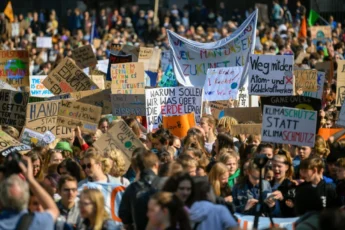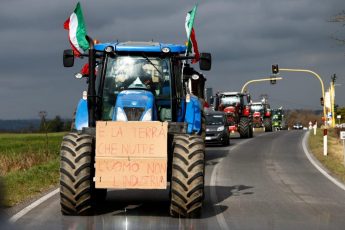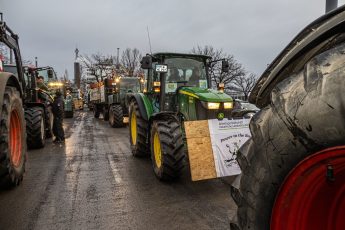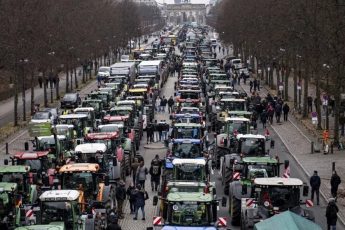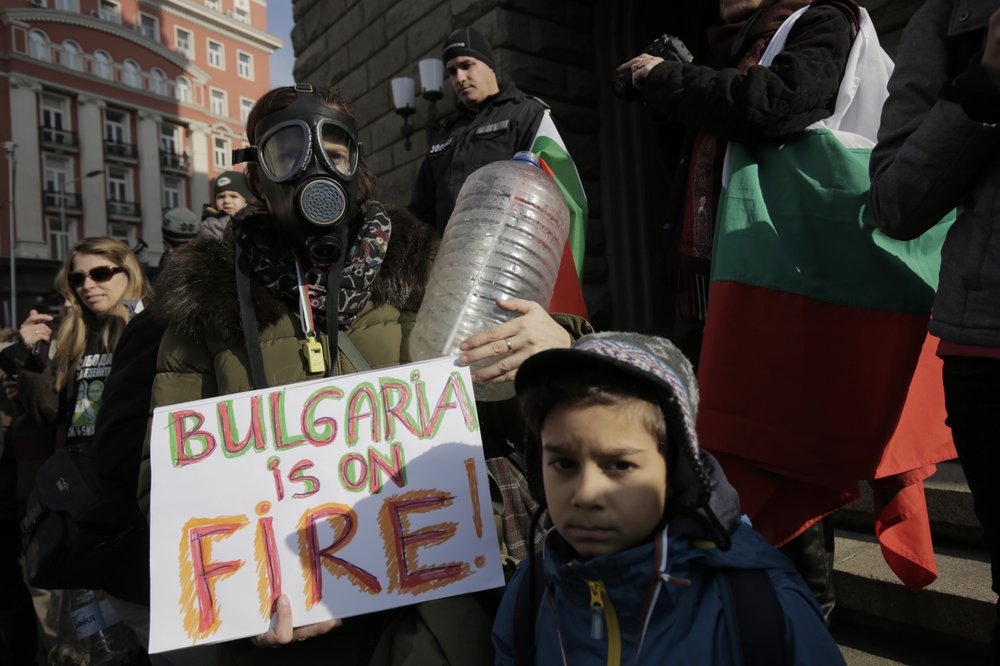
by Elitsa Kapusheva, Martina Karagyozova, Stanislav Dodov
Against the backdrop of the pressing entanglement of the war, health, economic, political, and climate crisis, local opposition against a large wind park investment project has been drawing the attention of Bulgarian media since early July. We publish this article written by three Bulgarian comrades who are part of our Climate Class Conflict transnational initiative and who engage in the local ecological movements. With their reflection, Stan, Martina and Elitsa attempt to unwind the media discourse burgeoning out of this case, and to use the generated media reports from the past months to analyze the shortcomings of the communication on the matters of renewable energy and large scale investments. Their interest for the way in which renewable energy projects appropriate practices of creating dependencies from the extractive industry help us understand how green and energy neoliberal policies reinforce existing hierarchies. Local communities are invested by these transnational movements of capital now looking for new occasions for accumulation within the ‘green’ field. Therefore we need the strength of a transnational movement to turn upside down the manifold effects of such governments, local authorities and capital convergence. A shorter version of this article will be part of our upcoming CCC – Journal.
Introduction
Europe’s green transition project seems to be on an even more cumbersome path than it was two years ago when the European Green Deal was officially approved and the policies were set in motion. Back in 2020 the main challenges before EU representatives and high functionaries were to convince their national counterparts and the broader public in the impermeability of the initiative, and to make the abstract idea of the Union’s full climate neutrality by 2050 more tangible. This attempt to re-establish the EU as a frontliner of green pioneership was supported by a political narrative balancing between boasting about the myriad entrepreneurial possibilities unlocked by the available funds for investment in green technologies, and ensuring that the green transition will also be a just one, with no one left behind (European Commission, 2019). However, the ripple effect ensuing from the global and regional crises piling on top of each other lit up, as per critique of scholars (e.g. Pianta & Lucchese, 2020; Samper, Schockling & Islar 2021), that the “leave no one behind” motto was not tailored to address the needs of people whose livelihoods are directly affected by the implementation of the green transition roadmap. With the ongoing energy crisis across Europe we see that the narrative of energy transition quickly shifted to one emphasizing on the necessity of securing viable energy additions (York and Bell, 2019). Whereby the sought additions are first and foremost natural gas suppliers other than Russia, or alternatively hydrogen or renewables, albeit not with the primary goal of transitioning to less carbon emissions.
It is in this context, but boiled down to the entanglement of crises on national level in Bulgaria and the subsequent shortcomings in communication and action, where the case with Vetrino municipality posing a first of a kind moratorium on wind turbines entered the spotlight of media attention. We took interest in this case as it can serve as a foundation for a broader discussion on where the overall public discourse about the green transition and its implementation fails to engage (with) affected communities.
The following examination covers the articles published in local and national media outlets in the period from July 2022 to November 2022. Our objective is to think through how the case and the involved actors were rendered for an extended readership, and how such media renditions deprive affected communities of public representation, sustaining the discourse that developers and green businesses know better than the locals. We think that the said disengagement of affected communities tells something important about the political economy of the transition, and how it plays out at the community level.
Although we strongly believe that the local community was not given equal tribune as the investors, in this contribution we won’t expand beyond the media coverage. One reason for that is practical: we had very limited capacity to deploy other methods. The other reason is that with such a limited capacity the chances that we will only reach out to people already influenced by special interests (which we explain later) were very high.
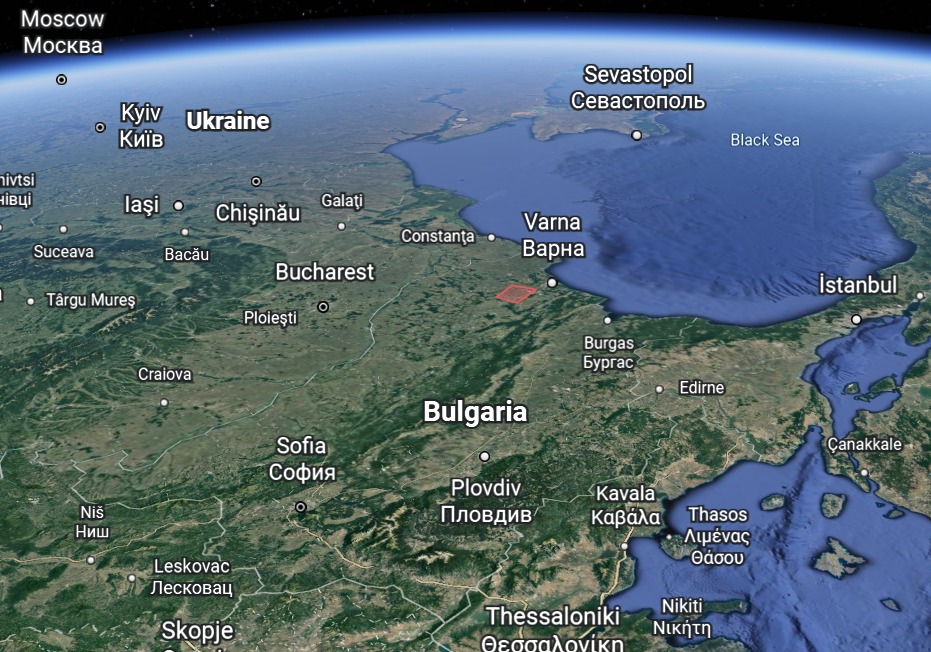
Vetrino and the wind(power) of change
Roughly translated Vetrino means with wind or windy, which hints to the favourable factors for wind energy production in the region. Vetrino is the name both of a municipality in Northeastern Bulgaria close to the city of Varna, which includes altogether 10 villages, and of the village that is the administrative centre of the municipality. According to the 2021 census, the number of residents in the municipality is 5089. The wind park project in question, Dobrotich Wind Park, is interested in developing a wind farm of 74 wind turbines on the territory of Vetrino Municipality and the neighbouring Valchi Dol Municipality. If built, the wind park will be among the largest such on the Balkans.
For the purposes of this article we take into consideration two intertwined timelines. On the one hand, the factual development around the wind park project, and the resulting local decisions. On the other, the chain of events or rather reactions following the rise of media interest on the matter. In a nutshell, Dobrotich Wind, is a joint-stock company established in 2009 (1). The company quickly becomes part of CWP Global – a renewables giant specialized in the development of wind and solar farms across Southeast Europe and Australia, and large-scale hydrogen hubs. In 2011, the Dobrotich Wind, already is backed up by CWP, and gets its first project approved. Since then, it has erected 35 wind turbines in Valchi Dol Municipality, near the village of Dobrotich. Building up on their presence in the region, in 2021 Dobrotich Wind officially submits a project proposal for a new large scale investment, which will finance the development of another 74 wind turbines on the territory of Vetrino Municipality. From the perspective of an outsider, i.e. not local residents and following only the news, the next milestone is that in June and July 2022 when local residents organize protests, and officially submit a petition to the local authorities opposing the wind park project. This, subsequently, leads to the municipal decision from July 8 to declare a full moratorium on building wind generators, regulating both industrial wind energy projects, and home wind turbines (2). Opting for something as cardinal as a moratorium turns out to be a surprising and controversial decision. That is because it implies that the municipal council acknowledged and responded to the pressure and claims of local residents, which is rarely the case in the neoliberal context, and especially in the face of high-value external investments. There are twofold reasons why the moratorium also raises controversies. On the one hand, because it takes place amidst a national political crisis and a heightened uncertainty regarding how Bulgaria will secure its energy security for the upcoming months. Although, a green light to the project doesn’t mean it will immediately add to the energy mix, it is natural that some people may perceive this as a rather cynical decision. Secondly, as confirmed by the legal advisor of the municipality, the ban on wind turbines contradicts ratified European directives on renewables, as well as national and regional strategic legal frameworks. In the aftermath, Dobrotich Wind filed a complaint to Varna administrative court, in which it is stated that by imposing a moratorium on wind turbines Vetrino Municipality breaches Bulgaria’s renewable energy legislation. On November 3, the administrative court in Varna ruled in favour of Dobrotich Wind and CWP (3). The argumentation behind this ruling is that imposing a moratorium of this kind is outside the authority of the municipality, as it contradicts not only European directives but also breaches Bulgarian law on renewable energy. As this is the most recent development at the time of writing, we can only speculate what will happen next. However, for the purposes of this examination, the court’s ruling presents a clear milestone within the case study at hand.
While the account so far sketches out the practical sequence of events, as stated above we operate with one more parallel timeline. Namely, one that traces when and how the case sparked media interest beyond local outlets, and what role does the respective coverage play in the formation of public opinion and reaction to the ongoing case. A quick search shows that neither of the three major television broadcasters has reported on the topic in their news segment. Following the moratorium decision, Bulgarian online outlet CAPITAL published a substantial investigative material on the wind park project and the civic and institutional reactions in Vetrino. The author reveals that apart from CWP there is one more business developer – Historical Park – who has interest and capacity to influence locals and persuade them against the wind park (Zapryanov, 2022). In fact, Zapryanov has previously reported for CAPITAL about the tourist attraction and the shady financing schemes leading to the enlargement of the Historical Park (Zapryanov, 2019). Commencing from here means that the journalist is somewhat familiar with what authority the people behind the Historical Park as major business developers may be wielding in the region.
This article marks the beginning of the broader media discourse on the matter as it was incredibly impactful (4). It triggered a snowball effect of media coverage. For instance, since its publication the Bulgarian National Radio took interest in the topic and featured a couple of materials, interviewing functionaries of Dobrotich Wind/CWP in discussion with representatives of the local opposition (e.g. BNR, 2022). Following CAPITAL’s material various other online media reproduced a version of the material, evoking similar reaction in the readers. Namely, that there is a developer with good intention for a large-scale investment in green technology, who is being sabotaged by an influential local corrupted business scheme. In the picture painted as such local residents are depicted simply as an instrument guided by a manipulation, and their position and activism is reduced to a collateral of a larger in-between businesses quarrel.
It should be noted that, despite the very high dependence of Bulgaria on coal, all public polling and research on public opinion in the past few years regarding the green transition in general, and renewables in particular, show a consistently significant majority in favour of the need to change the economy. Local advocates against the wind park are also making it clear that they are not against green energy as such. In other words some general disagreement with renewable energy and/or green policies is hardly a factor to be considered.
The local people voiceless and gaslighted
Out of around 20 news pieces from major media outlets we find that the only local voice present is that of the Historical Park CEO. However, he is in fact primarily a businessman, and he positions himself primarily as such. Then comes the “new” investor, the other business, and a major voice, Dobrotich Wind. The local people affected are the subject of some consultations and negotiations, and sometimes the subject of their own actions, but we only learn about all this second-hand through the voice of these two businesses, and rarely through that of local authorities.
The case is narrated as a battle between two business visions that advocate for two different political and socially responsible goals – one, for tourism business and supposed preservation of history and culture, and the other, for energy business and development of the region economically and sustainably. However, we do not learn whether these are really the only visions; even if the locals’ position has some relevance, it is only a function of these two visions; their authentic voice is unnecessary and is completely absent from the media discourse – we never learn about the local people’s opinions and experiences first-hand. For example, even the regional governor, commenting on the municipality’s moratorium on any wind turbine construction, says: “if the councillors at the municipality (5) reconsider their position, they will give the ‘green light’ in the discussion to hear expert opinions from different fields.” That is, it would be a good change not to hear the opinion of residents again (6).
Ultimately, it seems, the motivation behind any decision, apart from not going through or with the voice of the affected, is not about climate change as such or the locals’ wellbeing, but about a battle of business interests. In this battle the media discourse endorses very clearly what we could call corporate gaslighting. Under corporate gaslighting we understand the act of undermining local’s arguments and ecological, health, and economic concerns by dismissing them as unfounded, uneducated, or superstitious. Further, corporate gaslighting leaves the impression that local people are too naive to have their own legitimate reasons for doing or agreeing with something (or not). Hence, their position de facto is reduced to a blind following, being torn between listening only to the supposedly good new investor and the supposedly bad old investor. It is crucial to reiterate that these are the only voices that reach the public discourse. We hear from them various arguments pro and against the wind park, worded as an advice, a threat, or a promise given to an abstract public. On the one hand, the reasoning of the new investor and of pro-corporate media (like CAPITAL) constantly trivializes the motives of the locals as invalid: the wind park cannot have any unwanted ecological effects because ecology is the investor’s primary concern; the wind park cannot have any unwanted social and economic effects because were it not for the “old” investor to manipulate the people, they would have welcomed the new investments with open arms; the new investor cannot be accused of using European funds, because they use funds from European banks; allegedly there have been no problems with their existing wind park in Valchi dol, so there cannot be problems with the new one. The “old” investor, on the other hand, pushes through some obvious conspiracies about imminent plagues should the wind park get built (7), and threatens to “leave” and sell all their assets if new projects get approved. They also mobilize some of the local people – as evident by Zapryanov’s article, by using a Telegram group, as well as a newly created local newspaper. The call to action is grounded in the idea that the foreigners are coming to destroy their (local’s) traditions and ways of life. This argument posed as the main threat to the prosperity of the region aligns with the over-essenitalized yet kitschy, and to an extent peculiarly occult, form of nationalism, around which their entire business model for tourism revolves.
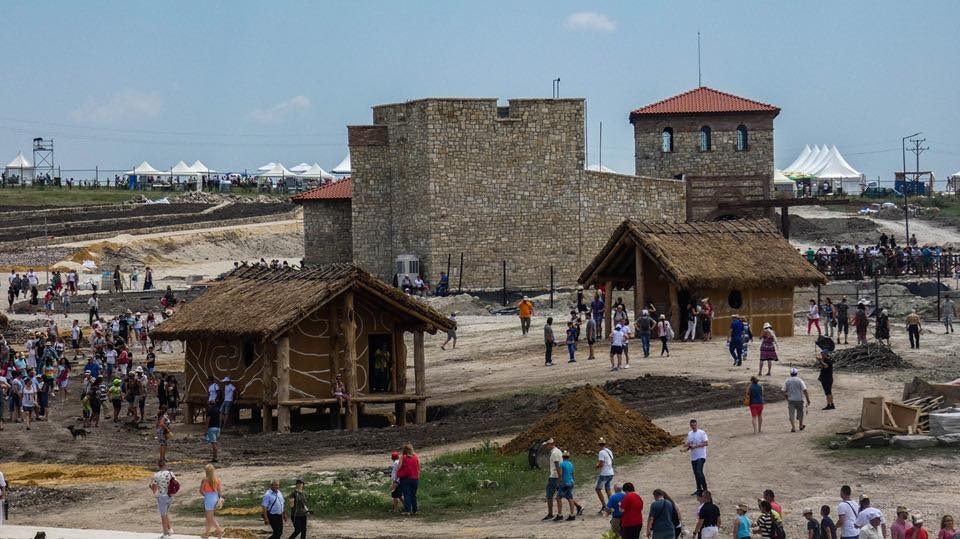
Comparing the case of Vetrino with the concept of aeolian politics, proposed by Howe and Boyer:
In a time when carbon incineration has been exposed as among the greatest ecological threats to humanity and other life on the planet, renewable energy forms, like wind power, are commonly assumed to have a clear, logical, and obvious salvational purpose: a path away from ‘pyromania’ (Scheer 2004) and toward ‘sustainability’. We are thus invited to embrace and support ‘wind power’ as an objective force for good. But in our research 1 we have found that ‘wind power’ is nowhere singular or objective and, if it is good, it is only for some and not for others. We thus develop an argument against a singular interpretation of ‘wind power’ and toward a surfacing of its manifold effects and ways of mattering. We call this domain: aeolian politics – the multiple and contingent political trajectories of the wind, as it is domesticated for electric energy, as it is made a commodity, and as it is taken as a redemptive metaphor for a world in climatological peril. (Howe & Boyer. 2015:32)
We see that the current paradigm of understanding the need and purpose of renewables within the European discourse on the green transition is not allowing for such a holistic and context-bound approach towards renewables. Gaslighting the idea that wind has multiple powers (as per Howe & Boyer), and reducing it solely to an energy resource, uncovers this exact inability.
There is yet another dimension of the case which makes the silencing and gaslighting of local people. As of November almost every democratic instrument available to locals by law to question the decision for the wind park has been used; only a local referendum has not been convened yet, but there is some talk around it. The ruling of the administrative court is effectively saying that the construction of the wind park cannot be stopped by any legal means, as there are national, European and even some local regulations and strategies that favour such industries over others.
All of these aspects of the discourse – the voicelessness, the gaslighting, the absence of holistic approach and the exhaustion of democratic means combine to close the horizon of possibilities available to local development. This closing has two significant implications. First is that the conflict will persist unresolved indefinitely, perhaps just suppressed. Second, that the horizon may be predetermined well beyond the specific case.
The local people feudalized
One of the significant features of the new investor’s last proposal to the municipality includes aid for households to cover part of their energy bills for the period of 35 years (mentioned in media coverage almost every time); educational and stipend programmes; a budget of 10 million BGN to be allocated according to the decisions of a special committee consisting of local authorities, civil organizations and the investor; and infrastructural improvements, among others. It certainly sounds tempting. “The sooner this happens, the better for the people”, says the CEO of Dobrotich Wind.
Such an approach to wide scale investments for the sake of local authorities accepting an offer have been around since forever, but what’s important is that renewable energy companies are transferring it directly as a good practice from extractive industries. This tells something important about the political economy of local and regional businesses succeeding in pushing their interests through.
Take Panagyurishte as a case in point – а small town in Central Bulgaria. Companies mining gold and copper in the region represent the biggest part of local economies, and are among the most significant soil and water polluters in the country (8). However, they also set a parasitic type of public infrastructure which slowly takes over otherwise degrading services and infrastructure provided by local and national authorities. It won’t be an exaggeration to say that today Panagyurishte is practically managed by the company Asarel-Medet and their cynical moto “From nature for people, by people for nature!”. Residential blocks, parks and gardens, sports halls, benches, fountains, roads – all have some signage that they were either built or renovated by the company. It has even built its own hospital over the old municipal one, closing the cycle of pollution and jobs that make people sick (the rates of oncological diseases in the region are extremely high). Locals would say that working conditions in the mines are fair, however Asarel-Medet remains the biggest employer and practical monopolist in the whole region. The entire story of local development revolves around the company, embodied specifically by the long-standing director and a philanthropist (as both the locals and he himself use the word philantropist). It’s a story of neo-feudalism in action (9). Vetrino too, should CWP/Dobrotich wind set foot as they plan, have all the potential to become a model of local neo-feudalized community.
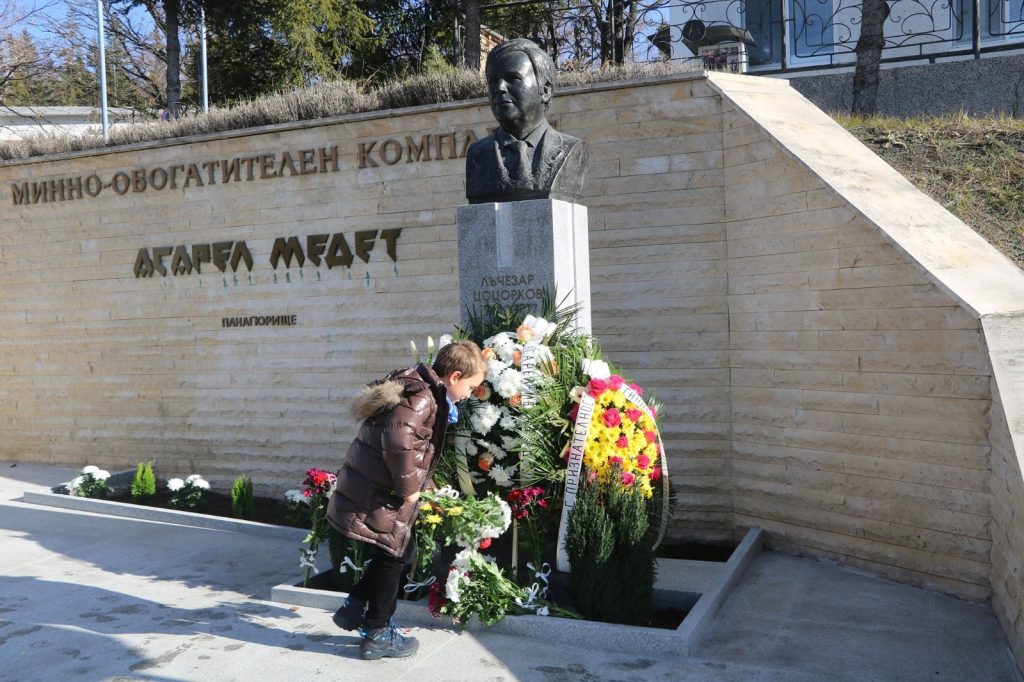
However, feudalization is already taking place. Neofit Rilski, the village neighbouring Vetrino 12 km to the southeast and also a part of Vetrino municipality, is practically devoured by the so-called Historical park – even the main Wikipedia image for the village is in fact an image of the park. Covering an area of around 5 km the amusement park pretends to be the biggest of its sort world-wide, and offers visitors a supposedly interactive journey back in time – “10 000 years through the five epochs of human civilization” (as public announcements put it), along with various entertainments like medieval duels, authentic foods, practice of crafts, etc. Then the story goes as expected: the park is the biggest employer in the region, but it also literally owns all land in the village. The difference with Panagyurishte is that it’s not about extractive mining, but about “extractive tourism”, and medieval assets are already available to complement the spirit of feudalism. This is where the “old” investor’s threat of leaving and selling everything should the wind park gets built, becomes important: a land and its serfs cannot have two lords.
In the end, perhaps, local people can only choose their lord, but nothing more, and it may be only natural that they prefer the one they already know, especially since he bears all the symbolic capital of patriotism fighting off colonial offensives (10). We could go even further and remember that according to Marx’s historical research of the transition from feudalism to capitalism in England (11), a serf may be to a certain degree better off under a caring lord, compared to a proletariat stripped of any possession and means of survival but their own body. The introduction of new capital, perceived as something foreign (especially in contrast to a nationalistic project) could well provoke imagery of the local economy and community entering a horrifying globalized capitalism stripping the people from their possessions. Of course, this is just a speculation.
What’s crucial is that a (neo-)feudalized organization of society is precisely a context in which political horizons are closing, and democratic life becomes unwanted and unnecessary. Using neo-feudalism as a prism to understand the political economy of the green transition on the local and regional level may prove to be a viable analytical tool, albeit also a very worrying sign of what is to come should other research confirm such findings.
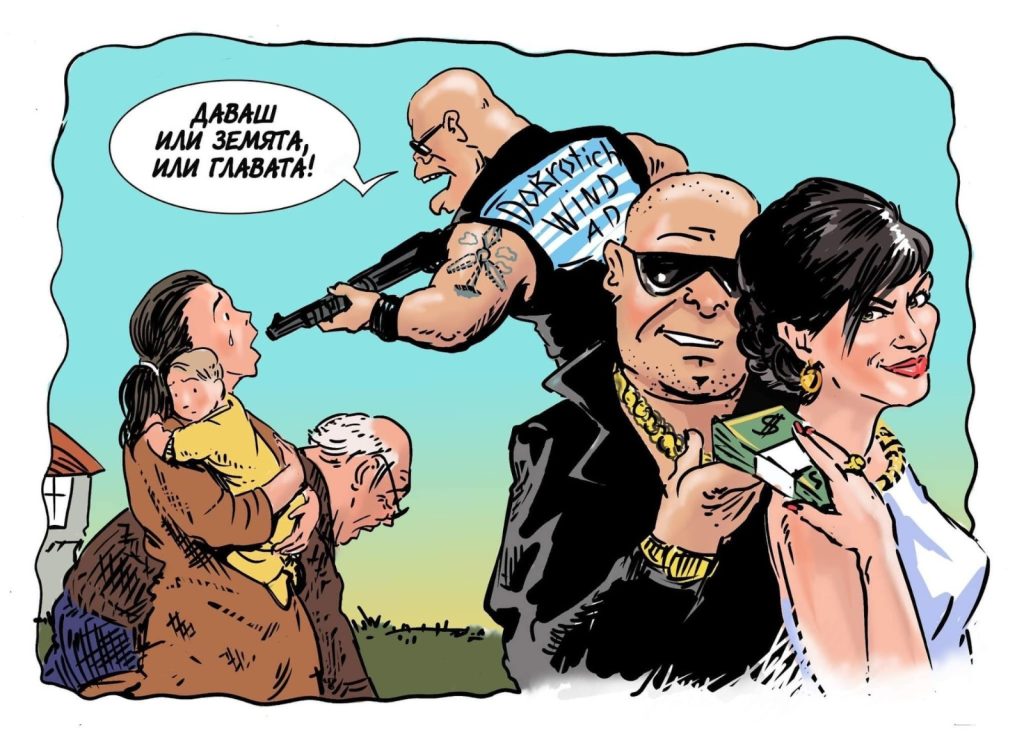
Conclusion
The presented case study, and moreover how it has been packaged by the surrounding media discourse, challenged us to rethink our assumption that ordinary people (as a generalized concept for affected communities, locals, workers etc.) are systematically deprived of access to platforms and means to voice their positions. Inquiring further we found a more discouraging reality. Namely, that given certain conditions the system, i.e. the framework of green transition, is somewhat welcoming towards political participation, but it is confined to having a performative capacity. This leads us to two hypotheses that require further investigation. First, the parameters of what is the right path to accomplishing the envisioned green transition are set in stone, and can’t be questioned especially by financially insignificant stakeholders. Second, the contradicting nature of the “leave no one behind” motto comes even more bluntly to the forefront: how are we ensuring that no one will be left behind if local and affected communities are not treated as legitimate voices?
These hypotheses open a couple of lanes for interpreting what are the breaking points for the class struggle in the context of the green transition. One is about the significance (or lack thereof) of representation. Be it on matters of renewables, or on concrete steps how to transit out of the old extractive industry (and into a new one?), communication with the Ordinary people is kept stagnate, and should they prove to be stubborn, they are disregarded as eligible stakeholders to participate in the negotiations. The path to green transition, at least in the case of the European Green Deal, is envisioned through the process of greening of the economic growth, and never as forms of degrowth and by extension the suppression of extractivism. In this framework, green technologies and renewables infrastructure projects are narrated as a success of the new green business order where the affected are deprived of agency. Simultaneously, the neoliberal state fully forsakes the basic task of facilitating communication between the parties, and instead it becomes an enabler for the said systemic success. In this (Bulgarian) context the lack of recognized participation of the ordinary people only deepens the crisis of representation present nationally for the past at least two years. It may turn out (but this hypothesis requires further investigation) that in order for the neoliberal state to prolong its otherwise undead existence into the new green regime, it would demand not only to suppress democratic participation or to keep it confined to performance, as it has been doing for quite a while, but also to suppress the imagery of participation, replacing it with bare second-hand narratives by the voices deemed legitimate, i.e. only businesses as representatives of the eligible visions.
Another lane involves seemingly peripheral questions to the matter of the inherent to the neoliberal green transition class conflict, but we deem them critical for future discussions. On the one hand, locally, as evident from the developments in Vetrino, we witness how nationalistic sentiments are being increasingly reinforced as an instrument for local mobilization. Although in the concrete case those self-portrayals alongside concerns about foreign investments being a new form of colonialism are being publicly dismissed as a product of external influence, those are legitimate anxieties that must be addressed. Studies on local resistance to renewables show the disastrous effects that land appropriation for environmental ends has for communities by evoking the feeling of being occupied and dispossessed of access to land (Argenti & Knight, 2015). In the domain of wind power, as a middle ground for enforcing the much-needed climate action that is also mindful of local concerns, a practical framework for actions out of Howe and Boyer’s aeolian politics may be fitting; a framework in which renewable sources and technologies are treated as commons, instead of a commodity, which in turn would require a common management of energy production (and provision). A key question before that – and it’s a question that remains unanswered to the best of our knowledge – is whether the overarching neoliberal framework had set in stone the scope and the direction of the green transition all over the map or if it is only the EU Green Deal so extremely inseverable from the neoliberal logic; it may well be that existing practices and regulations around the world provide better soil for an actually just transition.
Footnotes
- Status of the company in the Bulgarian Registry Agency available at https://bit.ly/3HcDbFK
- We did not find any explanation why the moratorium covers wind turbine for personal use as well. Although we can only speculate why this is so, we find this to be an interesting detail.
- Ruling of the Administrative court in Varna available at: https://bit.ly/3Uqg79m
- At the time of retrieving the article it has 60,255 views and 44 comments on the website of CAPITAL, which is significantly more than the average engagement.
- The municipal councils are the main governing bodies within the local authorities in Bulgaria. Councillors are elected and are supposed to represent the interests of citizens. As a small municipality, Vetrino has 13 councillors.
- Such absence from the public discourse of the affected locals and workers – affected both by climate change as such and by measures to tackle it – is reiterated in a recent research on public communication on climate change, conducted by The Orion grid in Bulgaria. As part of the research project, critical discourse analysis of nearly 200 pieces of media content in Bulgarian shows that if the affected are speaking with their own voice (in less than 3% of the materials), they only speak along scientists and experts, as if someone has to interpret their experiences and positions on their behalf; and they never speak along decision-makers, politicians, etc., as if they have nothing to communicate between each other.
- Even if the wind park poses some legitimate and proven risks for the environment – as it has been documented in various places – these risks are always specific for the specific ecosystem. Dobrotich wind’s project has successfully undergone the official procedure to evaluate the environmental impact. However, the details regarding those risks are never made clear neither from the side of the new investor, nor from the side of the objectors. In the words of the latter, risks like “low-frequency noise” or harms to local bird species remain vague and incoherent. We cannot judge whether this results from a lack of competence, insufficient preparation or from purposeful manipulation, but what matters is that arguments from the side of the objectors remain unconvincing in the overall gaslighting subtext of the case.
- See BlueLink, 2014: https://bit.ly/3VSIz4G
- The term “neo-feudalism” or new feudalism has been used in somewhat different senses since the 1960s. Here we mean the conceptualizations referring to the dependence of citizens on private powers within large areas where public institutions have in one way or another given up their authorities to corporate businesses.
- Protest pickets and signs are only mentioned in the articles we worked with but there is no visual materials depicting them. It is notable that the materials accompanied by portraits of the CEOs of Dobrotich Wind and the Historical Park.
- Chapter 26 of Capital Vol. I
References
Argenti, N., & Knight, D. M. (2015). Sun, wind, and the rebirth of extractive economies: renewable energy investment and metanarratives of crisis in Greece. Journal of the Royal Anthropological Institute, 21(4), 781–802. https://doi.org/10.1111/1467-9655.12287
BNR. (2022, October 31). Жители на варненски села искат референдум срещу проект за вятърен парк. (Bulgarian National Radio. Retrieved November 29, 2022, from: https://bnr.bg/horizont/post/101728971/jiteli-na-varnenski-sela-gotvat-referendum-sreshtu-proekt-za-vataren-park
European Commission. (2019). Communication from the Commission to the European Parliament, the European Council, the Council, the European Economic and Social Committee and the Committee of the Regions: The European Green Deal. Communication no. COM/2019/640. Brussels: European Commission. Accessed at: https:// eur- lex. europa. eu/legal- content/ EN/TXT/? uri= COM: 2019: 640:FIN
Pianta, M., & Lucchese, M. (2020). Rethinking the European Green Deal (Vol. 52, Issue 4). SAGE Publications. https://doi.org/10.1177/0486613420938207
Samper, J. A., Schockling, A., & Islar, M. (2021). Climate Politics in Green Deals: Exposing the Political Frontiers of the European Green Deal. Politics and Governance, 9(2), pp. 8–16. https://doi.org/10.17645/pag.v9i2.3853
Howe, C., & Boyer, D. (2015). Aeolian politics. Distinktion: Journal of Social Theory, 16(1), 31–48. https://doi.org/10.1080/1600910x.2015.1022564
York, R., Bell, S.E. (2019). Energy transitions or additions? Why a transition from fossil fuels requires more than the growth of renewable energy. Energy Res. Soc. Sci. 51, pp. 40–43
Zapryanov, Y. (2022, August 12). Защо “Исторически парк” спира вятърен проект за 1.2 млрд. Лв. Capital Weekly. [online]. Retrieved November 28, 2022, from: https://www.capital.bg/biznes/kompanii/2022/08/12/4378181_chuma_ot_viaturna_energiia_zashto_istoricheski_park/
Zapryanov, Y. (2019, June 11). Ханове и пирамиди или какво стои зад Историческия парк край Варна. Capital Weekly. Retrieved November 28, 2022, from: https://www.capital.bg/specialni_izdaniia/kapital_gradove/2019/06/15/3915771_hanove_i_piramidi/


